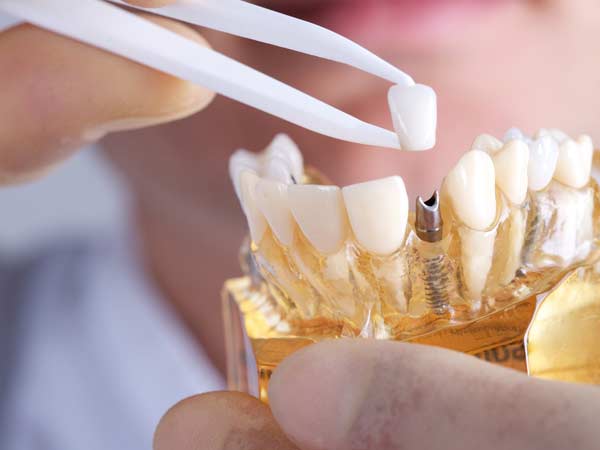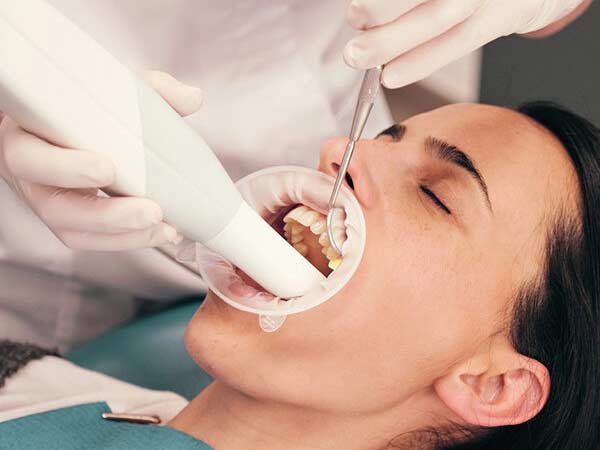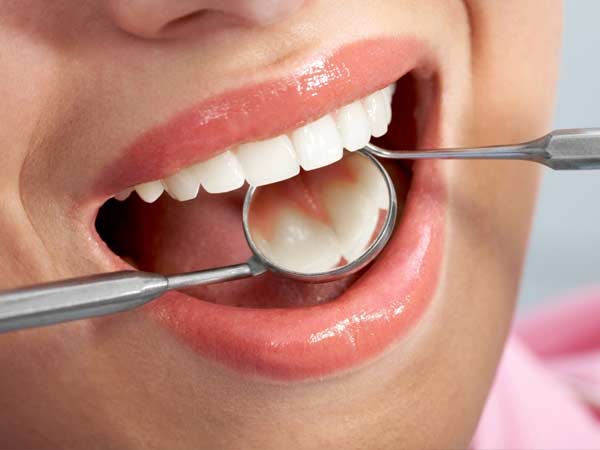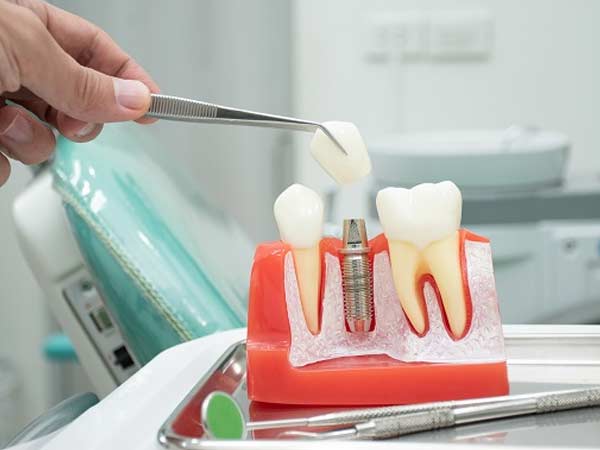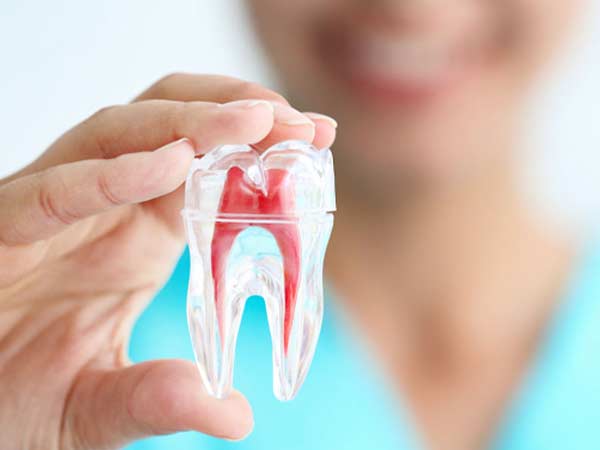Dental crowns are caps placed on top of damaged teeth. Crowns are used to protect, cover and restore the shape of your teeth when fillings don’t solve the problem. Dental crowns can be made out of metals, porcelain, resin and ceramics. They typically don’t require special care over time other than regular good oral hygiene.
What are dental crowns?
Over time, your teeth can get damaged. This can happen for a variety of reasons, like tooth decay, injuries or just use over time. Your teeth can lose their shape or size. Dental crowns are tooth-shaped “caps” that can be placed over your tooth. Think of it like a snug hat for your tooth. The crown restores the tooth’s shape, size, strength and appearance.
The dental crown is cemented into place on your tooth and it covers the visible portion of the tooth.
Why would I need a dental crown?
You may need a dental crown for several reasons, including:
- Protecting a weak tooth (possibly from decay) from breaking or to keep the weak tooth together if parts of it are cracked.
- Restoring a broken tooth or a severely worn down tooth.
- Covering and supporting a tooth with a large filling and not much tooth remaining.
- Holding a dental bridge in place.
- Covering misshapen or severely discolored teeth.
- Covering a dental implant.
- Covering a tooth that’s been treated with a root canal.
What are onlays and 3/4 crowns?
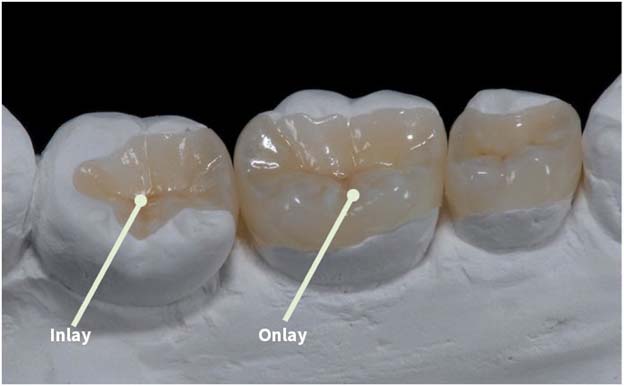
There are many types of crowns that can be used on your teeth. Onlays and 3/4 crowns are types of dental crowns that don’t cover as much of your underlying tooth as traditional dental crowns. A traditional crown will cover your entire tooth. Onlays and 3/4 crowns may be appropriate when you still have a solid tooth structure. It’s considered a more conservative approach compared to full coverage of your crown. In this procedure, your dentist removes the affected area and performs a reshaping of the tooth to receive the crown.
What are dental crowns made of?
Permanent crowns can be made out of many different materials. These materials can include:
- Metal: There are several metals that can be used in dental crowns, including gold, palladium, nickel and chromium. Metal crowns rarely chip or break, last the longest in terms of wear down and only require a small amount of your tooth to be removed. They can also withstand biting and chewing forces. The metallic color is the main drawback of this type of crown. Metal crowns are a good choice for out-of-sight molars.

- Porcelain-fused-to-metal: This type of dental crown can be matched to the color of the teeth that’s next to the crown. They have a more natural tooth color. However, sometimes the metal under the crown’s porcelain cap shows through as a dark line. Other cons include the chance of the crown’s porcelain portion chipping or breaking off and the crown wearing down the teeth opposite it within the mouth. This wear on the other teeth specifically affects the teeth that come into contact with the crown on the top and bottom of your mouth when it’s closed. Porcelain-fused-to-metal dental crowns can be a good choice for front or back teeth
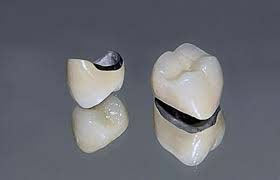
- All-resin: Dental crowns made out of resin are generally less expensive than other crown types. However, they wear down over time and are more likely to break than porcelain-fused-to-metal crowns.
- All-ceramic or all-porcelain: These types of dental crowns provide the best natural color match compared to any other crown type. They’re also a good choice if you have metal allergies. However, they aren’t as strong as porcelain-fused-to-metal crowns. They can also wear down the teeth opposite them in the mouth a little more than metal or resin crowns. All-ceramic crowns are a good choice for front teeth.
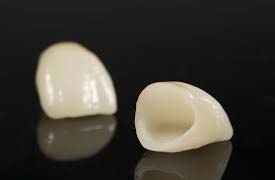
- Pressed ceramic: These dental crowns have a hard inner core. Pressed ceramic dental crowns replace the metal liner that’s used in the all-ceramic crown-making process. Pressed ceramic crowns are capped with porcelain, which provides the best natural color match. They’re also more long-lasting than an all-porcelain crown.
Procedure Details
How is my tooth prepared for a dental crown?
You will typically have two visits to the dentist to prepare for a dental crown. In some cases, you may have a dental crown made in your dentist’s office.
The first visit
During the first visit, the tooth that’s going to receive the crown is examined and prepared. X-rays are taken of the tooth and the bone around it. Your dentist might have to do a root canal treatment before your dental crown procedure if there’s any:
- Tooth decay.
- Risk of infection.
- Injury to the tooth’s pulp.
Pulp is the soft tissue inside your teeth that contains blood vessels, nerves and connective tissue.
The tooth that’s receiving the crown will be filed down across the top and sides. This will make space for the crown itself. The amount of tooth that gets filed away depends on the type of crown you have. All-metal dental crowns are thinner and don’t need as much of the tooth removed as all-porcelain or porcelain-fused-to-metal crowns. If too much of your tooth is missing — due to damage or decay — a filling material can be used to “build up” enough tooth structure for the crown to cover.
After reshaping the tooth, a paste or putty is used to make a copy (also called a impression) of the tooth that’s going to receive the crown. Impressions of the teeth above and below the tooth that’s getting the dental crown will also be made. This is done to make sure that the crown will not affect your bite.
The impressions are sent to a dental laboratory. The laboratory makes the crowns and usually returns them to the dentist’s office in two to three weeks. During this first office visit, your dentist will make a temporary crown to cover and protect the prepared tooth while you’re waiting on the permanent crown.
The second visit
At the second visit, the permanent crown is placed on your tooth. First, the temporary crown is removed and the fit and color of the permanent crown is checked. If everything is okay, a local anesthetic (“numbing” drug) is sometimes used to numb the tooth and the new crown is permanently cemented in place.
Same-day dental crowns
Dental crowns can also be made in a dentist’s office if your dentist has the equipment. This process starts off similarly to the traditional way a crown is made — the first steps are to remove decay and shape the tooth for a perfect fit inside the crown. After these steps, the actual making of the crown is different. In the same-day procedure, a scanning device (a “wand”) is used to take digital pictures of the tooth inside your mouth. The computer’s software creates a 3D model of the tooth from these pictures. The digital design is then sent to another in-office machine that carves the shape of the crown out of a block of ceramic. This method of making a dental crown is called computer-aided design/computer-aided manufacturing (CAD/CAM). In less than 15 minutes, the crown is ready to be cemented into place.
Risks / Benefits
What problems can develop with a dental crown?
There are several issues that you might experience over time with your crown, including:
- Discomfort or sensitivity: A newly crowned tooth may be sensitive immediately after the procedure as the anesthesia begins to wear off. If the crowned tooth still has a nerve in it, you may experience some heat and cold sensitivity. Your dentist might recommend that you brush your teeth with toothpaste designed for sensitive teeth. Pain or sensitivity that happens when you bite down usually means that the crown is too high on the tooth. If this is the case, call your dentist. This problem is easily fixed.
- Chipped crown: Crowns made of all porcelain can sometimes chip. Small chips can be repaired and the crown can remain in your mouth. The dental crown may need to be replaced if the chip is large or when there are many chips.
- Loose crown: Sometimes, the cement that holds the crown on can wash out from under the crown. Not only does this allow the crown to become loose, it allows bacteria to leak in and cause decay to the tooth that remains. If your crown feels loose, contact your dentist’s office.
- Crown falls off: A dental crown can actually fall off. When this happens, it’s usually due to an improper fit or a lack of cement. If this happens to you, reach out to your dentist’s office immediately. Your dentist will give you specific instructions on how to care for your tooth and crown until you can come in for an appointment. The dentist may be able to re-cement your crown in place. If the crown can’t be put back in place, a new crown will need to be made.
- Allergic reaction: The metals used to make dental crowns are often a mixture of several metals. You can have an allergic reaction to the metal or porcelain that’s used in the dental crown. However, this is extremely rare.
- Dark line on crowned tooth next to the gum line: You might see a dark line next to the gum line of your crowned tooth. This is normal — particularly if you have a porcelain-fused-to-metal crown. This dark line is simply the metal of the crown showing through.
Recovery and Outlook
How long do dental crowns last?
On average, dental crowns last between five and 15 years. The life space of a crown can depend on the amount of “wear and tear” the crown is exposed to, how well you follow oral hygiene practices and personal mouth-related habits. These mouth-related habits can include things like:
- Grinding or clenching your teeth.
- Chewing ice.
- Biting your fingernails.
- Using your teeth to open packaging.
Does a crowned tooth require any special care?
A crowned tooth doesn’t need any special care. However, the underlying tooth still needs to be protected from decay or gum disease. Because of this, you should continue to follow good oral hygiene practices. These practices include brushing your teeth twice a day and flossing once a day — especially around the crown area where the gum meets your tooth. Also, avoid biting on hard surfaces with porcelain crowns (for example, chewing ice or popcorn hulls) to prevent cracking the porcelain.



